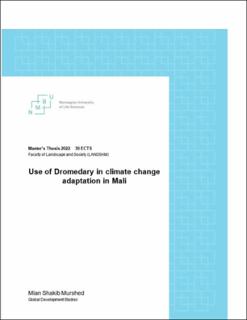| dc.description.abstract | Dromedary (Camelus dromedarius) is commonly known for its climate robustness. This study was undertaken in Mali, a country characterized by a poverty rate of 41.9%. Two-thirds of Mali is made up of arid and semi-arid areas. This country has faced several droughts during the last five decades and is a country very much exposed to climate change. The objective was to assess dromedary as a climate change adaptation tool and to study services by dromedary that can be used in times of stress to improve food security.
This research has three major approaches, a bio-physical study of dromedaries, a socio-economic study, and a key informant interview among the dromedary herders’ community. The study found that the principal dromedary activities are grazing, walking, resting, watering, and rutting. The research station of Niono is in the Sahelian zone (400-500 mm/year of rain), and the research station of Sotuba is in the sub-humid zone (800-1000 mm/year of rain). Despite location and season, Grazing remains the main activity (61.7% in Niono and 53.2% in Sotuba). Dromedary adjusts the actions to have access to sufficient fodder and water. Grazing time was higher during the rainy season (80.0% in Niono and 65.0% in Sotuba) than in the cold dry season (62.0% in Niono and 58.0% in Sotuba) and the hot dry season (60.0% in Niono and 59.0% in Sotuba). Dromedary tends to move faster and longer to collect required fodder in areas where fodder is scarce. Sotuba (25.5%) has a higher resting time than Niono (8.8%). When dromedary grazes, they do not eat everything from a plant but eat the most palatable part and keep the rest for the future. The study found that dromedary’s reproductive capability did not change much between locations. The fertility rate was about 90% at both sites. Dromedaries provide several services important for food security, such as milk and meat production. Dromedary milk is also essential for nomadic people to meet their protein and food demand. 88.0% of respondents answered that the milk is intended for self-consumption or given to neighbors or relatives who do not have the means. Also, in 98% of cases, it is being managed and preserved by the females of the household. Though camel milk has a market value, most (87.6% of herders) don’t want to sell due to cultural reasons. The survey showed that the season impacts camel milk production; production was 2.6 l/day during the rainy season and 1.3 l/day during the dry season. It was also observed that in southern areas of Mali milk production per dromedary was lower than in areas further to the north with less rainfall. | en_US |

